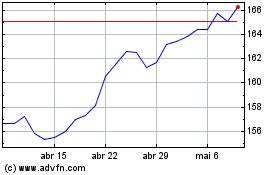By James R. Hagerty
This article is being republished as part of our daily
reproduction of WSJ.com articles that also appeared in the U.S.
print edition of The Wall Street Journal (March 16, 2019).
Alfred "Al" Zeien, who was chief executive of Gillette Co. in
the 1990s, led the maker of razorblades through one of its most
glorious eras and retired just as growth began to stall.
Under Mr. Zeien (pronounced "zane"), the company's sales doubled
and its market value soared to about $63 billion in early 1999 from
$6 billion in 1991. His fans included Warren Buffett, whose
Berkshire Hathaway Inc. owned more than 10% of the company.
Mr. Zeien, who died Feb. 18 at age 88, presided over the launch
of the three-bladed Mach 3 shavers in 1998. Meanwhile, he
diversified Gillette with the acquisition of Duracell International
and expanded the company's pen business with the purchase of Parker
Pen of England. But Duracell's batteries didn't create the
anticipated jolt to growth, partly because gadgets switched to
rechargeable power. The pen business ran dry and was later
sold.
Procter & Gamble Co. bought Gillette in 2005 for about $57
billion of stock.
At a time when many other U.S. companies were outsourcing their
manufacturing, Mr. Zeien, an engineer, kept investing in laser
welding and other techniques needed for ever-more-complicated
shaving contraptions. In the shaving business, "we have more people
in our R&D and engineering department designing the
(production) equipment than the product," he told The Wall Street
Journal in 1992.
As CEO, he insisted that what he called "growth drivers" --
R&D, capital investment and ad spending -- should rise at least
as fast as sales.
Nowhere was facial hair taken more seriously than at the company
founded by King C. Gillette in the early 1900s. "We spend more time
than you can imagine studying facial hair growth -- which is quite
different from the growth of other hair on your head -- because
that's the way to improve your product," Mr. Zeien said.
Gillette researchers calculated that the average man had 30,000
whiskers on his face and that they grew 15/1,000ths of an inch a
day, or 5 1/2 inches a year. Dry beard hair, they discovered, was
about as tough as copper wire of the same thickness.
Gillette workers volunteered to shave at the company's South
Boston manufacturing plant daily and record their impressions of
the various blades they tested.
"We own the face," Donald Chaulk, vice president of Gillette's
shaving technology laboratory, told this newspaper in 1992. "We
know more about shaving than anybody. I don't think obsession is
too strong a word."
Mr. Zeien did his bit for research. Many mornings he tried two
different razors, one for each side of his face. "That's the only
way to really compare shaves," he said.
When Gillette introduced the Mach 3 blades in 1998, it said they
made shaving less like scraping and more like painting.
The Duracell acquisition was supposed to be another triumph.
Gillette said its enviable international distribution network,
built for razorblades and other items, would help increase Duracell
sales in overseas markets including India and China. Unlike with
razors, though, Gillette had no obvious technological edge in
batteries that would persuade people to pay a premium.
Alfred Michael Zeien was born Feb. 25, 1930, in New York and
grew up in the Jackson Heights section of Queens. His father, a
maker of high-end wood furniture, was born in Luxembourg. His
mother emigrated from France.
Al Zeien graduated from the Webb Institute on Long Island with a
degree in naval architecture and then worked for a company that
made minesweepers during the Korean War. He married Joyce Lawrence,
a portrait painter, whom he had met in high school. In 1955, he
earned an M.B.A. degree from Harvard University. Around the same
time he joined General Dynamics Corp., where he held various jobs
and eventually headed the company's shipyard in Quincy, Mass.
When Boston-based Gillette purchased Braun AG in 1968, Mr. Zeien
was recruited to help run the German maker of electric shavers. He
was based in Germany for several years before returning to Boston
for a variety of executive roles, including development of the
highly successful Sensor range of razors. He became chairman and
CEO of Gillette in 1991.
Though he generally got glowing reviews in the press, Mr. Zeien
endured withering criticism from people opposed to animal testing
of consumer products. "Let this be a warning to you," a
sixth-grader in Philadelphia wrote in a 1995 letter to the CEO. "If
you hurt another animal, if I find out, one month from this letter
arrives to you, I'll bomb your company. P.S. Watch your back."
Gillette responded that it had cut back on animal testing and
was looking for alternatives.
After he retired in 1999, Mr. Zeien had more time for his hobby
of sailing along the coast of New England.
He is survived by three children, five grandchildren and one
great grandson. His wife of 64 years, Joyce, died in 2017. His son
Scott recalled that when he asked his father how he was doing, Mr.
Zeien's answer was invariable: "Thriving."
Write to James R. Hagerty at bob.hagerty@wsj.com
(END) Dow Jones Newswires
March 16, 2019 02:47 ET (06:47 GMT)
Copyright (c) 2019 Dow Jones & Company, Inc.
Procter and Gamble (NYSE:PG)
Gráfico Histórico do Ativo
De Mar 2024 até Abr 2024

Procter and Gamble (NYSE:PG)
Gráfico Histórico do Ativo
De Abr 2023 até Abr 2024
